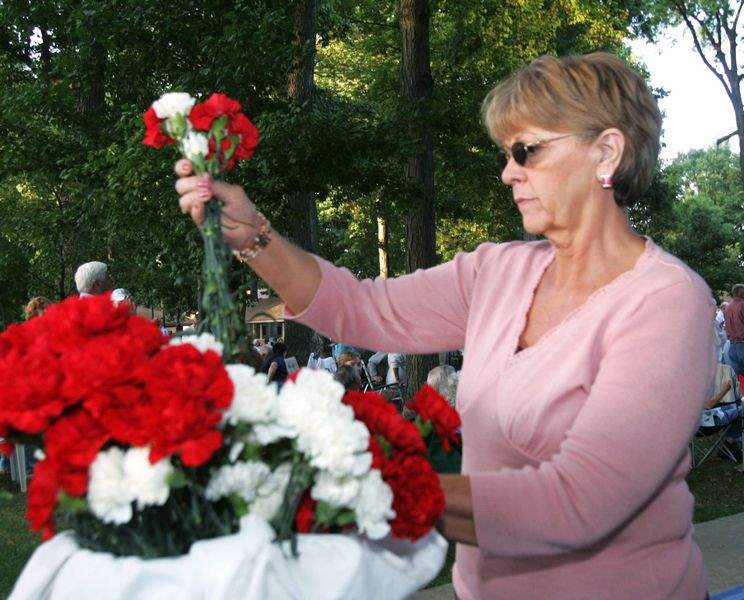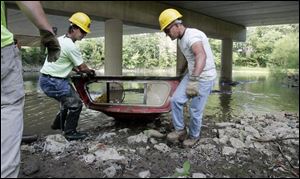
Victims of flood mark anniversary with heart, hope
8/22/2008
Pam Rettig of Findlay gathers flowers to give out to people to save or throw into the adjacent Blanchard River as part of the one-year commemoration of the August, 2007, flood.
Jetta Fraser / The Blade
Buy This Image

Findlay residents Brian Bibler, left, and Eric Stroub work for the National Emergency Grant Project clearing debris from the Blanchard River in Findlay.
FINDLAY Four days a week, Brian Bibler pulls logjams and trees, tires, and appliances from the Blanchard River. The other three, he works on his house, just a stone s throw from the river that left him and hundreds of others homeless one year ago.
I m still working on my house, Mr. Bibler said during a break. I just moved back into it three weeks ago. It s livable now.
Like others who live along the flood-prone Blanchard, he said that for the 20 years he s lived on Findlay Street, high water frequently surrounded his home during heavy rains but never crept inside.
On Aug. 22, 2007, all that changed.
I had 30 inches in the back part of my house, 18 in the front, said Mr. Bibler, 46, who worked sporadically as a union carpenter.
I have a camper in my backyard and the water was 6 foot high on that.
After the flood, he moved in with his former in-laws and, over the winter, took a job with a work crew hired with federal emergency grant dollars to remove flood debris from the river.
I came to work for them because the river needs to be cleaned up, Mr. Bibler said. The union s mad at me, but it was something I felt I had to do I hope it will make a difference.
In the aftermath of the river s second worst flood on record, officials up and down the watershed are working hard on long-term solutions to the flooding problems that have intensified in Findlay and Ottawa in recent years.
The Northwest Ohio Flood Mitigation Partnership, an organization formed in the wake of the flood and funded largely by major corporations in Hancock and Putnam counties, has an ambitious goal of getting long-term flood mitigation projects under construction by 2012.
Those could include building retention basins, flood walls, levies, and a number of other flood control measures.
Last August s flood intensified pressure on federal officials to such a degree that the U.S. Army Corps of Engineers now is conducting a feasibility study of the river aimed at determining what measures would best control flooding along the Blanchard.
Both Findlay and Ottawa also are in the process of purchasing homes that were substantially damaged in the August flood, razing them, and leaving the property as green space in perpetuity.
That process has been a slow one, though.
Ottawa just received approval from the Federal Emergency Management Agency to move ahead with acquiring and clearing a now-abandoned mobile home park along U.S. 224 and up to 16 homes in town, while Findlay is still waiting for grant approval for the 16 properties on its expedited list.
Those folks are the ones that are really still being hurt by the flood because they re waiting for these grant dollars to have their properties bought out, yet they re not living in them, said Tony Iriti, president of the flood mitigation partnership.
They re living in a second home or renting The process by which FEMA approves those grants has taken much longer than what was anticipated initially.
In both communities, there are residents who remain displaced, businesses that are still vacant.
Eyeing the future
Some property owners, including the village of Ottawa, still are wrangling with FEMA over compensation for losses caused by the flood.
In the meantime, they re looking to the future.
I truly believe we are on the right track to mitigate the problems we are having, said Jeff Loehrke, Ottawa s community development director. If people can just hang on a couple more years, there is a better tomorrow coming their way.
That s not to say the communities along the Blanchard won t be faced with more floods before long-terms fixes are made.
I fully expect us to have another flood event. Just how bad of a flood remains to be seen, but how can we not? Mr. Loehrke said.
Every time heavy thunderstorms start coming our way, I wonder is this the one? I fully expect it to happen, but I think we re better prepared to deal with it.
There is light at the end of the tunnel, he added. We re not just sitting back with our blinders on saying, It s not going to happen. It s not going to happen. Because it is going to happen.

Pam Rettig of Findlay gathers flowers to give out to people to save or throw into the adjacent Blanchard River as part of the one-year commemoration of the August, 2007, flood.
Findlay Mayor Pete Sehnert hopes he won t have to see it in his lifetime. He said the city is prepared to handle another severe flood. But with the economy in a slump, recovery would be challenging at best.
You know you can only take so much, he said. I think we bounced back really well, but how many times can you take a hit and bounce back as well?
Tax increase plan
He is behind the Hancock County commissioners plan to impose a 0.75 percent sales tax increase, with a third of the new revenue earmarked for flood mitigation.
The cost of long-term flood control measures is expected to be shared with the federal government, although estimates put the local share in excess of $50 million.
Down the road, there s definitely going to be a list of projects, Mr. Sehnert said.
We re going to be faced with: This is A project and this is what it s going to cost. This is B project and this is what it s going to cost. This is the C project and this is what it s going to cost. Now what do you want to do?
I think people are behind [the tax], he added. I think they know the importance of getting it done now and not letting it slip by again, he said.
The Long Term Recovery Committee of Hancock County, a volunteer group that sprang up shortly after last year s flood, has not run out of work a year after the flood waters receded.
Needy families
Rebecca Noack, a member of the committee and a former United Way director, said that in the last year the group has helped more than 230 needy families return to safe, sanitary, and secure living conditions and it expects to remain in place for at least another year.
We have 28 open cases as of today, and two are brand new cases this week, Ms. Noack said, explaining that some home owners are just beginning to see the effects of the flood in their now-crumbling foundations and corroded hot water heaters.
Since we had two cases call this week, we know there is still a need, she said.
For the last two nights, the recovery committee held evenings of song and reflection at Findlay s Riverside Park in commemoration of the flood anniversary.
The committee s counterpart in Putnam County is sponsoring an ecumenical service at 10:30 a.m. Sunday followed by a community picnic at Ottawa Memorial Park.
The Rev. Steve Elderbrock, pastor of Ottawa Presbyterian Church and a member of the long-term recovery task force in Putnam County, said some people have asked him why the event is being billed as a celebration.
Our intent is to focus on the positive impacts how far we ve come in a year, how we ve recovered all the positives that have come out of this awful event like bringing the community closer together, making us more aware of disasters, all the support that has come from within the community and from outside, he said.
Pastor Elderbrock said he recently was at a conference where an official from Grand Forks, N.D., spoke about the devastating flood that city survived in 1997.
He said it really made them stronger, Pastor Elderbrock said.
I m hoping that in 10, 11 years we will be able to say, It was an awful event, but we re stronger communities because of it.
Contact Jennifer Feehan at:jfeehan@theblade.comor 419-353-5972.